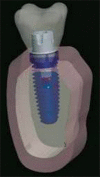Comparative effect of implant-abutment connections, abutment angulations, and screw lengths on preloaded abutment screw using three-dimensional finite element analysis: An in vitro study
- PMID: 29692570
- PMCID: PMC5903180
- DOI: 10.4103/jips.jips_219_17
Comparative effect of implant-abutment connections, abutment angulations, and screw lengths on preloaded abutment screw using three-dimensional finite element analysis: An in vitro study
Abstract
Purpose: The purpose of this study is to compare the effect of implant-abutment connections, abutment angulations, and screw lengths on screw loosening (SL) of preloaded abutment using three dimensional (3D) finite element analysis.
Materials and methods: 3D models of implants (conical connection with hex/trilobed connections), abutments (straight/angulated), abutment screws (short/long), and crown and bone were designed using software Parametric Technology Corporation Creo and assembled to form 8 simulations. After discretization, the contact stresses developed for 150 N vertical and 100 N oblique load applications were analyzed, using ABAQUS. By assessing damage initiation and shortest fatigue load on screw threads, the SL for 2.5, 5, and 10 lakh cyclic loads were estimated, using fe-safe program. The obtained values were compared for influence of connection design, abutment angulation, and screw length.
Results: In straight abutment models, conical connection showed more damage (14.3%-72.3%) when compared to trilobe (10.1%-65.73%) at 2.5, 5, and 10 lakh cycles for both vertical and oblique loads, whereas in angulated abutments, trilobe (16.1%-76.9%) demonstrated more damage compared to conical (13.5%-70%). Irrespective of the connection type and abutment angulation, short screws showed more percentage of damage compared to long screws.
Conclusions: The present study suggests selecting appropriate implant-abutment connection based on the abutment angulation, as well as preferring long screws with more number of threads for effective preload retention by the screws.
Keywords: Dental; implant; preload; screw.
Conflict of interest statement
There are no conflicts of interest.
Figures




Similar articles
-
Influence of occlusal forces on stress distribution in preloaded dental implant screws.J Prosthet Dent. 2004 Apr;91(4):319-25. doi: 10.1016/j.prosdent.2004.01.016. J Prosthet Dent. 2004. PMID: 15116032
-
Finite element analysis to determine implant preload.J Prosthet Dent. 2003 Dec;90(6):539-46. doi: 10.1016/j.prosdent.2003.09.012. J Prosthet Dent. 2003. PMID: 14668754
-
Screw loosening and changes in removal torque relative to abutment screw length in a dental implant with external abutment connection after oblique cyclic loading.J Adv Prosthodont. 2018 Dec;10(6):415-421. doi: 10.4047/jap.2018.10.6.415. Epub 2018 Dec 19. J Adv Prosthodont. 2018. PMID: 30584470 Free PMC article.
-
Review of the Mechanical Behavior of Different Implant-Abutment Connections.Int J Environ Res Public Health. 2020 Nov 23;17(22):8685. doi: 10.3390/ijerph17228685. Int J Environ Res Public Health. 2020. PMID: 33238476 Free PMC article. Review.
-
Mechanism of and factors associated with the loosening of the implant abutment screw: A review.J Esthet Restor Dent. 2019 Jul;31(4):338-345. doi: 10.1111/jerd.12494. Epub 2019 May 31. J Esthet Restor Dent. 2019. PMID: 31150572 Review.
Cited by
-
Evaluation of customized cobalt-chromium abutments fabricated with different manufacturing process versus titanium stock abutments on the marginal misfit -An in vitro study.J Indian Prosthodont Soc. 2022 Jul-Sep;22(3):225-232. doi: 10.4103/jips.jips_381_21. J Indian Prosthodont Soc. 2022. PMID: 36511051 Free PMC article.
-
A finite element analysis to study the stress distribution on distal implants in an all-on-four situation in atrophic maxilla as affected by the tilt of the implants and varying cantilever lengths.J Indian Prosthodont Soc. 2020 Oct-Dec;20(4):409-416. doi: 10.4103/jips.jips_70_20. Epub 2020 Oct 8. J Indian Prosthodont Soc. 2020. PMID: 33487969 Free PMC article.
-
Abutment screw loosening in implants: A literature review.J Family Med Prim Care. 2020 Nov 30;9(11):5490-5494. doi: 10.4103/jfmpc.jfmpc_1343_20. eCollection 2020 Nov. J Family Med Prim Care. 2020. PMID: 33532384 Free PMC article. Review.
-
Correlation between abutment angulation and off-axial stresses on biomechanical behavior of titanium and zirconium implants in the anterior maxilla: A three-dimensional finite element analysis study.J Indian Prosthodont Soc. 2019 Oct-Dec;19(4):353-361. doi: 10.4103/jips.jips_268_19. Epub 2019 Oct 10. J Indian Prosthodont Soc. 2019. PMID: 31649445 Free PMC article.
-
A Novel Technique Using Polytetrafluoroethylene Tape to Solve Screw Loosening Complication in Implant-Supported Single Crowns.Int J Environ Res Public Health. 2020 Dec 27;18(1):125. doi: 10.3390/ijerph18010125. Int J Environ Res Public Health. 2020. PMID: 33375404 Free PMC article.
References
-
- Chee W, Jivraj S. Failures in implant dentistry. Br Dent J. 2007;202:123–9. - PubMed
-
- Di Iorio D, Sinjari B, Feragalli B, Murmura G. Biomechanical aspects in late implant failures: Scanning electron microscopy analysis of four clinical cases. J Contemp Dent Pract. 2011;12:356–60. - PubMed
-
- Henry PJ, Laney WR, Jemt T, Harris D, Krogh PH, Polizzi G, et al. Osseointegrated implants for single-tooth replacement: A prospective 5-year multicenter study. Int J Oral Maxillofac Implants. 1996;11:450–5. - PubMed
-
- Jemt T, Pettersson P. A 3-year follow-up study on single implant treatment. J Dent. 1993;21:203–8. - PubMed
LinkOut - more resources
Full Text Sources
Other Literature Sources
